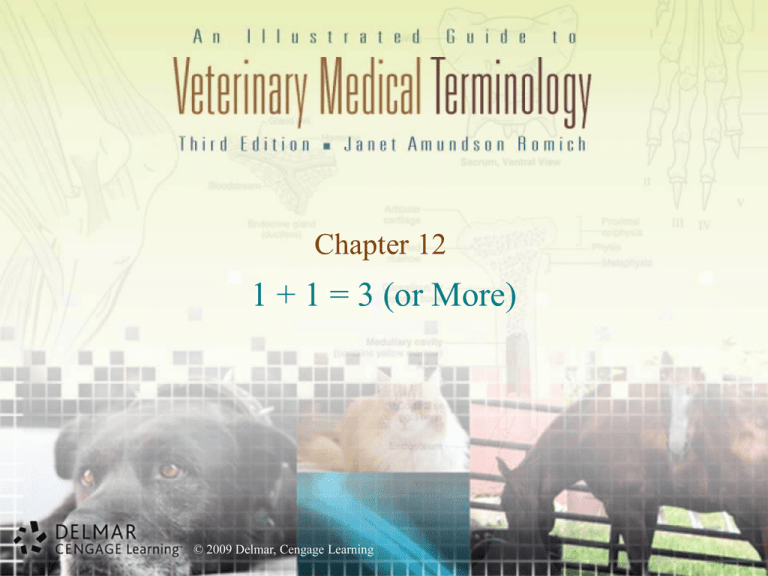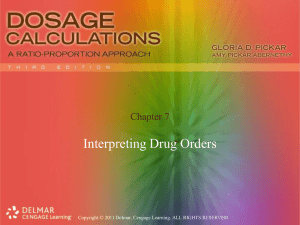
Chapter 12
1 + 1 = 3 (or More)
© 2009 Delmar, Cengage Learning
The Reproductive System
• The reproductive system is responsible
for the act of producing offspring.
– Both male and female organs are needed.
• Theriogenology means animal reproduction.
• Ovaries and Testes are also part of the
endocrine system (gonads)
© 2009 Delmar, Cengage Learning
The Male
Reproductive System
• The male reproductive system is
responsible for the production and
delivery of sperm to the egg to
create life.
• The structures of the male reproductive
system include the scrotum, testes,
epididymis, vas deferens, accessory sex
glands, urethra, and penis.
© 2009 Delmar, Cengage Learning
© 2009 Delmar, Cengage Learning
The Scrotum
• The scrotum or
scrotal sac is the
external pouch
that encloses and
supports the testes
– The combining
form for the
scrotum is
scrot/o.
• .Epidymis and Ductus
Deferens is also found
here
© 2009 Delmar, Cengage Learning
The Testes
• The testes or testicles
are the male sex glands
that produce
spermatozoa.
– The combining forms for
the testes are orch/o,
orchi/o, orchid/o, test/o,
and testicul/o.
– Testis is the singular form
of testes.
© 2009 Delmar, Cengage Learning
The Epididymis
• The epididymis is the
tube at the upper part of
each testis that secretes
part of the semen, stores
semen, and provides a
passageway for sperm.
– The combining form for
the epididymis is
epididym/o.
– Semen is the fluid that the
sperm is suspended in.
© 2009 Delmar, Cengage Learning
The Vas Deferens
• The vas (ductus)
deferens is the tube
connected to the
epididymis that
carries sperm into
the pelvic region
toward the urethra.
© 2009 Delmar, Cengage Learning
Vas Deferens
Neuter
A “tunic” surrounds the testis, and epidymis
The “cut” is made at the Vas Deferens
© 2009 Delmar, Cengage Learning
1. Testis and epidymis
Enclosed in tunic
2. Incision is made in
tunic
3. Testis (followed by
Epidymis and Vas
Defrens)
4. Tunic is separated and
© 2009 Delmar, Cengagetucked
Learning back into the dog
© 2009 Delmar, Cengage Learning
If you ever wondered…
• The testes produce the sperm (and
testosterone)
• The testicles are the testes,
the vas deferens and the epidymis
The two terms are often used interchangeably,
But really do have slightly different meanings.
© 2009 Delmar, Cengage Learning
The Accessory Sex Glands
• The accessory sex glands include the
seminal vesicles, prostate gland, and
bulbourethral gland.
– Seminal vesicles secrete a thick substance that nourishes
sperm.
– The prostate gland secretes a thick fluid that aids in the
motility of sperm.
– The bulbourethral gland secrete a thick mucus that acts as a
lubricant for sperm.
• Not all glands are present in all species.
© 2009 Delmar, Cengage Learning
The Accessory Sex Glands
© 2009 Delmar, Cengage Learning
The Urethra
• The urethra is a tube
passing through the penis
to the outside of the body
that serves the
reproductive and urinary
systems.
– The combining form for the
urethra is urethr/o.
© 2009 Delmar, Cengage Learning
© 2009 Delmar, Cengage Learning
The Female
Reproductive System
• The female reproductive system is
responsible for the creation and support of
new life.
• The structures of the female reproductive
system include the ovaries, uterine tubes,
uterus, cervix, vagina, vulva, and mammary
glands.
© 2009 Delmar, Cengage Learning
© 2009 Delmar, Cengage Learning
The Ovaries
• The ovaries are a small pair of
organs located in the caudal
abdomen.
• The ovaries produce estrogen,
progesterone, and ova (eggs).
• The combining forms for ovary are
ovari/o and oophor/o.
© 2009 Delmar, Cengage Learning
The Ovaries
• Follicle Stimulating Hormone
and Luteinizing Hormone
stimulate the ovaries (cycle).
• The ovaries produce estrogen
to prepare the reproductive
tract for breeding
• After ovulation (release of
mature ova) ovary produces
progesterone to maintain
pregnancy
© 2009 Delmar, Cengage Learning
The Uterine Tubes
• The uterine tubes are
paired tubes that
extend from the cranial
portion of the uterus to
the ovary (although
they are not physically
attached to the ovary).
• Also called fallopian
tubes or oviduct.
© 2009 Delmar, Cengage Learning
The Uterine Tubes
• The uterine tubes carry
ova from the ovary to the
uterus and transport
sperm.
© 2009 Delmar, Cengage Learning
The Uterus
• The uterus is a thickwalled, hollow organ
with muscular walls
and a mucous
membrane lining.
• Animals have
extensions called
uterine horns.
• The combining forms for
the uterus are hyster/o,
metr/o, metri/o, and
uter/o.
© 2009 Delmar, Cengage Learning
The Cervix
• The cervix is the caudal
continuation of the uterus and
the cranial continuation of
the vagina.
• The cervix prevents foreign
substances from entering the
uterus.
© 2009 Delmar, Cengage Learning
Human Reproductive Tract
© 2009 Delmar, Cengage Learning
Terms: Reproductive Phases
• Proestrus
– Follicles of ovary start to grow
– Estrogen is produced
– Lining of uterus develops
• Estrus
– Female is receptive/ “in heat”
• Diestrus
– Corpus luteum develops
– Estrogen production subsides
– Progesterone is produced
• Anestrus
– Cycle is at rest
© 2009 Delmar, Cengage Learning
The Placenta
• The placenta is the female organ of mammals that
develops during pregnancy and joins mother and offspring
for exchange of nutrients, oxygen,
and waste products.
– The placenta is often referred to as the afterbirth.
© 2009 Delmar, Cengage Learning
The Placenta
• The umbilical cord is the structure that forms where
the fetus communicates with the placenta.
• The umbilicus is the structure that forms on the
abdominal wall where the umbilical cord was
connected to the fetus.
– The combining form for umbilicus is umbilic/o.
© 2009 Delmar, Cengage Learning
Pregnancy and Birth
• Pregnancy is the condition of having a
developing fetus in the uterus and is the
time period between conception and
parturition.
– The combining form for pregnancy is pregn/o.
© 2009 Delmar, Cengage Learning
Pregnancy and Birth
• Gestation is the period of development of
the fetus in the uterus from conception to
parturition and is the term more commonly
used in animals.
– The combining forms for gestation are gest/o and
gestat/o.
© 2009 Delmar, Cengage Learning
Pregnancy and Birth
• Parturition is the act of giving birth.
– The combining form for giving birth is part/o.
© 2009 Delmar, Cengage Learning
Pregnancy and Birth
• Parturition is divided into stages:
– first stage = dilation of the cervix
– second stage = uterine contractions and delivery of the
fetus
– third stage = separation of the placenta from the uterus
© 2009 Delmar, Cengage Learning
Pathological Condition
•
•
•
•
Cryptorchid
Pyometra
Dystocia
C-section
© 2009 Delmar, Cengage Learning
Cryptorchid
• Crypt/o = Hidden
• Orchid/o = Testes
• Monorchid
• Testicle never made it to the scrotum
• Can be difficult to locate
– abdominal
– Inguinal
Dogs should be neutered!
genetic (inherited “defect”)
prone to cancer
© 2009 Delmar, Cengage Learning
Other male “problems”
• Up to one month after being neutered sperm
may still be present in other areas of the
repro tract
• Paraphimosis–
–
–
–
inability to retract the erect penis back within the prepuce.
can cause tissue necrosis (cut off blood supply)
needs to be cleaned, lubricated, and placed back inside prepuce
What is the prepuce – “foreskin”
© 2009 Delmar, Cengage Learning
Pyometra
•
•
•
•
Pyo = pus
Metr/o = uterus
Bacteria make their way into uterus
Closed pyo –cervix is closed/ closed environment
– -no where for pus to go
• Open pyo –cervix is open, infection can drain out
• Tends to occur about a month after estrus
© 2009 Delmar, Cengage Learning
• Pyometra Surgery
– https://www.youtube.com/watch?v=H7o611VAiB0
– Start at 2 min
© 2009 Delmar, Cengage Learning
Dystocia
• Difficult birth
–
–
–
–
–
Size of babies
Age of the female
Condition/health of the female
Strength of contractions
Size of the birth canal
© 2009 Delmar, Cengage Learning
When is it dystocia?
• Parturition that does not occur within 24 hr
after a drop in rectal temperature to <100°F
• strong abdominal contractions lasting for 1–2 hr
without passage of a puppy or kitten
• a resting period during active labor >4–6 hr
• Pain
• abnormal vulvar discharge
eg, frank blood,
dark green discharge before any neonates are born
[indicates placental separation]
© 2009 Delmar, Cengage Learning
C-Section
• Caesarian Section
– Pups or Kittens are in placental sacs within the
horns of the uterus
© 2009 Delmar, Cengage Learning
C-Section
• https://www.youtube.com/watch?v=j7hzobft254
• https://www.youtube.com/watch?v=0HhrgON5MxY
– Start at 2 min
© 2009 Delmar, Cengage Learning
Spay/ Neuter Surgeries
• Spay (Ovariohysterectomy)
– Ovari/o = ovary
– Hyster/o = uterus
– https://www.youtube.com/watch?v=scxfdiruTTw
• Watch starting at 7 minutes
• ( https://www.youtube.com/watch?v=tWKuDbXZm5E)
• Neuter
• https://www.youtube.com/watch?v=C6OS7jKA5Dc
© 2009 Delmar, Cengage Learning
The END!
© 2009 Delmar, Cengage Learning
Medical Terms for the
Reproductive System
• Additional terms for reproductive system
tests, pathology, and procedures can be
found in the text.
• Review StudyWARE to make sure you
understand these terms.
© 2009 Delmar, Cengage Learning
The Mammary Glands
• Mammary glands are composed of connective tissue
organized into lobes, lobules, and alveoli.
• The combining forms for the mammary glands are
mamm/o and mast/o.
© 2009 Delmar, Cengage Learning
The Placenta and
Associated Structures
• The innermost membrane
that envelopes the fetus is
the amnion.
• The innermost layer of
the placenta that forms a
sac between itself and the
amnion is the allantois.
• The outermost layer of
the placenta is the
chorion.
© 2009 Delmar, Cengage Learning






